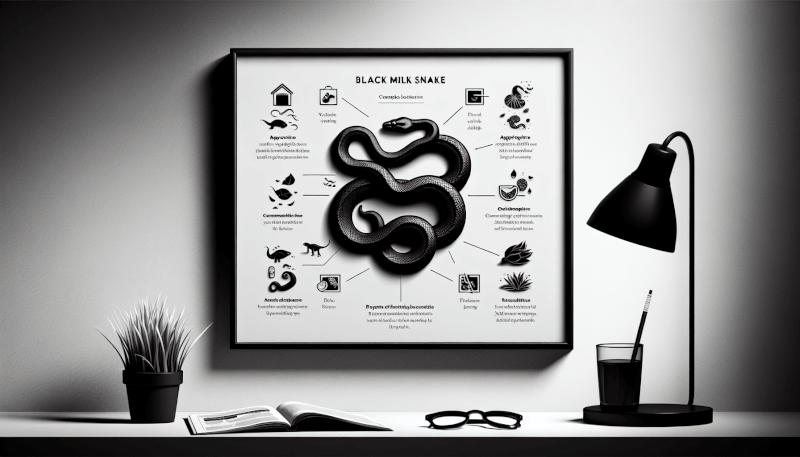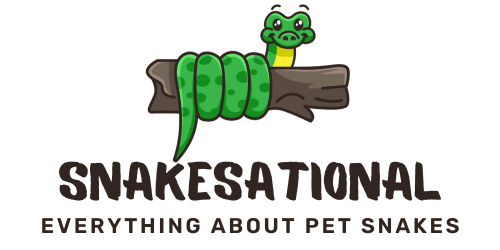Are you a snake enthusiast looking to add a beautiful and mysterious reptile to your collection? Look no further than the captivating black milk snake! In this article, we will guide you on the essentials of black milk snake care, helping you create a welcoming and safe environment for your new scaly friend. From habitat setup to feeding schedules, we’ve got you covered, ensuring that your black milk snake thrives under your watchful care. So get ready to embark on an exciting journey into the world of black milk snake care!

Habitat Setup
Choosing an Enclosure
When setting up a habitat for your black milk snake, it’s important to choose the right enclosure. An ideal option is a glass terrarium with a secure lid to maintain the necessary temperature and humidity levels. The size of the enclosure depends on the snake’s size and activity level, but generally, a 20-gallon tank is suitable for an adult black milk snake.
Substrate
The substrate you choose for your black milk snake should mimic its natural habitat and provide a comfortable and clean living environment. Aspen shavings or reptile-safe mulch are excellent options. Avoid using substrates that can cause respiratory issues, such as cedar chips or pine shavings.
Temperature and Lighting
Maintaining the proper temperature and lighting is crucial for the health and well-being of your black milk snake. Provide a temperature gradient in the enclosure, with a warm side around 85°F (29°C) and a cooler side around 75°F (24°C). Use an under-tank heating pad or heat lamp to achieve this gradient. Additionally, provide a UVB light source for 10-12 hours a day to support the snake’s overall health.
Humidity
Black milk snakes require a moderately high humidity level to aid in shedding and ensure proper respiratory function. Maintain a humidity level of around 60-70% by misting the enclosure with water and providing a humid hide, which can be a small enclosed box with damp substrate in one corner of the enclosure.
Hiding Spots
Providing hiding spots in your black milk snake’s enclosure is essential to create a stress-free environment. Use various sizes and types of hides, such as half logs, rock caves, or commercially available snake hides. Place them on both the warm and cool sides of the enclosure to allow the snake to regulate its body temperature and feel secure.
Cleaning and Maintenance
Regular cleaning and maintenance are necessary to keep your black milk snake’s habitat clean and hygienic. Spot clean any waste or soiled substrate as needed and perform a thorough cleaning of the enclosure every 2-3 months. Replace the substrate, wash the decor and hides, and sanitize the enclosure using a reptile-safe disinfectant. This routine helps prevent the buildup of bacteria and ensures a healthy living environment for your snake.
Feeding
Dietary Requirements
Black milk snakes are carnivores, and their diet consists mainly of appropriately sized rodents. The size of the prey should be proportional to the snake’s girth, with young snakes typically consuming pinky or fuzzy mice and adults feeding on adult mice or small rats. It’s important to feed your snake pre-killed prey to prevent injury.
Feeding Schedule
Establishing a regular feeding schedule is important for maintaining your black milk snake’s health and well-being. Young snakes should be fed every 5-7 days, while adults can be fed every 10-14 days. Adjust the frequency as needed, considering factors like the snake’s metabolism, growth rate, and activity level.
Feeder Options
There are various feeder options available for black milk snakes. The most common choices include frozen-thawed rodents, live rodents, or pre-killed rodents. Frozen-thawed rodents are the preferred option as they reduce the risk of injury to both the snake and the prey. Ensure that the prey items are of appropriate size and quality to meet your snake’s dietary needs.
Feeding Technique
When offering food to your black milk snake, use feeding tongs or specialized snake feeding forceps to simulate live prey movement. This mimics the natural hunting behavior of the snake. Place the prey item near the snake’s head, gently wiggling it to stimulate a feeding response. Allow the snake to consume the prey without interruption, and if the snake does not eat within 15-20 minutes, remove the prey to prevent stress or potential injury.
Handling and Temperament
Proper Handling Techniques
When handling your black milk snake, it’s essential to prioritize the safety and comfort of both you and the snake. Wash your hands before handling to remove any scents or residues that may startle the snake. Gently support the snake’s body and avoid sudden movements to prevent stress. Allow the snake to explore and move at its own pace, giving it a sense of security and control.
Understanding Temperament
Black milk snakes, like many reptiles, vary in temperament. Some individuals may be more docile and tolerant of handling, while others may be more defensive or skittish. Spend time observing your snake’s behavior and body language to understand its temperament. Establishing a bond of trust and respect with your snake will help create a positive handling experience for both of you.
Handling Frequency
While handling can be enjoyable and beneficial for snakes, it’s important not to overdo it. Handling frequency should be kept to a minimum to avoid causing undue stress or compromising the snake’s health. Aim for short, gentle handling sessions once or twice a week, gradually increasing the duration as your snake becomes more accustomed to handling.
Health and Wellness
Regular Veterinary Check-ups
Regular veterinary check-ups are essential for maintaining your black milk snake’s overall health and detecting any potential health issues early on. Find a reptile-experienced veterinarian who can provide routine examinations, fecal parasite screenings, and offer guidance on nutrition and proper care.
Common Health Issues
While black milk snakes are generally hardy, they can still experience certain health issues. Some common ailments include respiratory infections, skin infections, and parasites. Monitor your snake closely for any signs of illness and consult a veterinarian if you notice any abnormalities in behavior, appetite, or physical appearance.
Signs of Illness
Knowing the signs of illness in a black milk snake can help identify potential health issues promptly. Common signs of illness include decreased appetite, weight loss, lethargy, excessive shedding, abnormal feces, respiratory distress, or any visible abnormalities on the skin or body. If you observe any of these signs, seek veterinary care promptly.
Handling Shedding
As with other snakes, black milk snakes shed their skin periodically as they grow. Ensure that the humidity level in the enclosure is adequate during the shedding process to promote a smooth and complete shed. Provide a humid hide filled with damp moss or substrate, which will aid in the shedding process and prevent any retained shed.
Preventing Parasites
Parasite prevention is crucial for the well-being of your black milk snake. Regularly inspect your snake for external parasites, such as mites, and use a reptile-safe treatment if required. Additionally, ensure that the enclosure remains clean and sanitized to minimize the risk of internal parasites. Regular fecal screenings by a veterinarian can help detect and address any internal parasite issues.

Breeding
Age and Maturity
Breeding black milk snakes should only be considered when both the male and female snakes have reached adequate maturity. Generally, this occurs around 2-3 years of age. Ensure that both snakes are in good health and have reached the appropriate size for breeding, usually a weight of 300-500 grams for females and 200-300 grams for males.
Mating Process
When breeding black milk snakes, it’s essential to introduce the male and female in a controlled environment. Observe their behavior closely for signs of courtship, such as the male gently rubbing against the female or extended periods of coiling together. Mating can occur multiple times over a few days, and it’s important to provide a separate enclosure for the female to rest after breeding.
Nesting Requirements
After successful breeding, the female black milk snake will require appropriate nesting conditions to lay her eggs. Provide a separate nesting box with a suitable substrate, such as vermiculite or perlite, that is moderately damp but not overly wet. Ensure a stable temperature around 80°F (27°C) and monitor the humidity levels to facilitate proper egg development.
Incubation and Hatching
Gently collect the eggs and transfer them to an incubation container, such as a plastic deli cup or an egg incubator. Maintain the temperature within a narrow range of 80-82°F (26-28°C) and monitor the humidity levels consistently. The incubation period typically lasts around 45-60 days, depending on the temperature. Once the eggs start hatching, it’s crucial to handle the hatchlings with care and provide appropriate housing and feeding.
Caring for Hatchlings
Hatchling black milk snakes require specific care to ensure their healthy development. Provide small enclosures with appropriate temperature and humidity levels, mimicking the conditions in the wild. Use appropriately sized hides and offer suitable prey items, such as newborn pinky mice, fed every 5-7 days. Regularly monitor their growth and overall health, consulting a veterinarian if any issues arise.
Common Mistakes
Inadequate Habitat Setup
One common mistake is not providing a suitable habitat for black milk snakes. Inadequate enclosures, suboptimal temperature and humidity levels, or a lack of hiding spots can lead to stress, poor health, and compromised well-being for the snake. It’s crucial to invest time and effort into creating a proper habitat that meets the snake’s needs.
Improper Feeding Practices
Feeding mistakes can often result from inadequate research or understanding of the snake’s dietary requirements. Incorrect prey sizes, inadequate feeding schedules, and using live prey without supervision can all lead to health issues for your black milk snake. Educate yourself on proper feeding practices and consult with a reptile expert to ensure the best care for your snake.
Neglecting Health Check-ups
Neglecting regular veterinary check-ups for your black milk snake can have serious repercussions. Routine examinations, fecal screenings, and preventative treatments are essential for early detection and treatment of health issues. Establishing a relationship with a reptile-experienced veterinarian is vital to ensure the ongoing well-being of your snake.
Inadequate Handling Techniques
Handling mistakes can cause stress, injury, or discomfort to your black milk snake. Rough handling, sudden movements, or excessive handling frequency can lead to defensive behaviors or health issues. Educate yourself on proper handling techniques and be mindful of your snake’s comfort and well-being during every interaction.
Lack of Knowledge about Breed Characteristics
Lack of knowledge about the specific characteristics and needs of black milk snakes can lead to improper care and misunderstandings. Understanding their natural habitat, feeding habits, shedding process, and breeding requirements is essential for providing optimal care. Take the time to learn about black milk snakes and their unique characteristics to ensure their well-being.
Availability and Legality
Legal Considerations
Before acquiring a black milk snake, it’s important to research and understand the legal considerations surrounding their ownership. Different jurisdictions may have specific regulations or restrictions regarding the keeping and breeding of exotic reptiles. Ensure that you comply with all applicable laws and obtain any necessary permits or licenses.
Sources for Obtaining Black Milk Snakes
When looking to obtain a black milk snake, it’s important to source them from reputable breeders or sellers. Avoid purchasing from sources that engage in illegal or unethical practices, such as smuggling or trading endangered species. Look for breeders or sellers who prioritize the health and welfare of their snakes and can provide information on the snake’s lineage and health history.
Responsible Breeders and Sellers
Responsible breeders and sellers prioritize the well-being of the snakes they breed and sell. They provide proper care, maintain clean and healthy environments, and ensure that the snakes are in good health before being sold. Seek out breeders or sellers with a positive reputation, good customer reviews, and a commitment to ethical and responsible practices.
Educational Resources
Books and Publications
There are numerous books and publications available that provide in-depth information on black milk snakes and reptile care in general. Look for reputable sources written by herpetologists or experienced snake enthusiasts. These resources can provide valuable insights into their natural history, care requirements, and breeding techniques.
Online Forums and Communities
Online forums and communities dedicated to reptiles and snake care can be excellent sources of information and support. Participate in discussions, ask questions, and seek advice from experienced snake owners and breeders. However, it’s important to verify the credibility of the information shared and consult with a veterinary professional for any specific concerns or issues.
Professional Herpetological Organizations
Professional herpetological organizations, such as the Herpetologists’ League or the American Society of Ichthyologists and Herpetologists, can offer valuable resources and guidance for snake owners. These organizations often provide access to scientific journals, research articles, and conferences related to reptiles. Explore their publications and events to stay informed about the latest discoveries and advancements in the field of herpetology.
Interacting with Other Pets
Safety Precautions
When interacting with other pets, such as cats or dogs, it’s crucial to prioritize the safety of both your black milk snake and the other animals. Always supervise interactions to prevent any aggressive behaviors that may harm your snake. Be mindful of the temperament and prey drive of your other pets when introducing them to your snake.
Supervised Interactions
Supervised interactions between your black milk snake and other pets can provide enriching experiences and opportunities for socialization. However, ensure that interactions are controlled and guided to avoid any harm to either the snake or the other animals. Never leave your snake unattended with other pets, even if they have shown tolerance or interest in the past.
Introducing Black Milk Snake to Other Pets
Introducing your black milk snake to other pets should be done gradually and with caution. Start by allowing them to smell each other’s scents through a closed enclosure or a barrier. Over time, gradually introduce them in controlled and supervised sessions, observing their behavior closely. If any signs of aggression or stress are displayed, separate the animals immediately.
Conclusion
Summary of Care Requirements
Taking care of a black milk snake involves providing the right habitat setup, proper feeding, appropriate handling, and regular health check-ups. It requires maintaining suitable temperature, humidity, and lighting conditions, as well as providing a balanced diet of appropriately sized prey. Timely veterinary care, understanding the snake’s temperament, and responsible breeding practices are crucial for their well-being.
Appreciating the Beauty of Black Milk Snakes
Black milk snakes are captivating reptiles known for their vibrant colors and striking patterns. Their glossy black bodies with bold red, orange, or yellow bands make them a stunning addition to any reptile enthusiast’s collection. Observing their natural behavior and unique characteristics can deepen your appreciation for these beautiful animals.
Rewarding Experience as a Reptile Owner
Caring for a black milk snake can be a rewarding and enriching experience. With proper research, education, and dedication, you can provide a safe, healthy, and stimulating environment for your snake. Building a bond of trust and respect through gentle handling and attentive care will create a satisfying and fulfilling reptile ownership experience. Enjoy the journey of being a responsible black milk snake owner!


